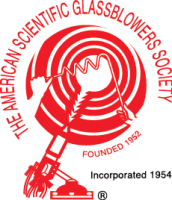2015 Technical Paper Presentations
(Click on the presenter name to see a short bio.) Robert Ponton – “Batman, the Lone Ranger and the Chemist” Batman had Robin, the Lone Ranger had Tonto and of course. The Chemist has The Glassblower! The relationship between scientists and the glass shop dates from the earliest alchemist to the modern day research laboratory. This paper will be presented as a talk glassblowers can give to other groups like The American Chemical Society, Sigma Xi and others. We will hop scotch through history as we document the long rich history of scientific collaboration between the scientist and the glassblower. Alexander V. Zabula and Tracy Drier – “Structure and transformation of Glass” -Department of Chemistry, University of Wisconsin-Madison, Madison, WI (USA) Glass was one of the first artificial materials created at the earliest stages of civilization. Currently, a great amount of various glass materials are fabricated to satisfy the esthetic, practical, and scientific demands of our modern society. The unique properties of glass originate from its structure. From a physical viewpoint, glass behaves both as a liquid and a solid substance. The amorphous nature of glass and lack of long-range translation periodicity significantly limits the number of physical-chemical instrumentation techniques applicable for structural analysis. In this overview, the most important structural properties of glass including softening, melting, stresses, defects, color, polarization and dichroic effects as well as photosensitivity will be discussed. Special attention will be centered around the structural modifications of glass upon common glassblowing manipulations. Brian Markowicz – “Manufacture and Maintenance of Glassware used in Isotopic Analysis” Scientific Glassblower, Chemistry & Biochemistry, Georgia Tech College of Science. Atlanta, Georgia (USA) The purpose of this paper is to explore the types of glassware that I have been asked to manufacture and/or maintain for the purpose of preparing samples for isotopic analysis. This includes traditional vacuum lines used for the loading of samples and standards for combustion, as well as vacuum lines for the cleaning, separation, measurement and bottling of sample gases for use in isotope ratio mass spectrometry. I will also cover a lesser known sample prep line used to convert carbon dioxide into the graphite powder that is needed for age dating by Accelerator Mass Spectrometry. Tsuyoshi Nakamura – “Making a Cube Trap” (Japan) How to make a complex small cube trap including techniques of how to cut the glass, drilling flat glass, fusion of glass plates and assembling of all parts. Kevin E. Bennet and Steven M. Anderson – “Chemical Vapor Deposition of Diamonds for Deep Brain Stimulation” Scientific Glassblowers, Mayo Clinic Invention Labs. Rochester, Minnesota (USA) The design and fabrication of a chemical vapor deposition reactor for the creation of diamond with boron doping is key to neurotransmitter detection in the brain. We describe the design and construction of a reactor successfully used to synthesize diamond. The process was used to fabricate chemical sensing deep brain probes using fast scan cyclic voltammetry. These electrodes are being used to develop an understanding of deep brain stimulation with the Read More …

